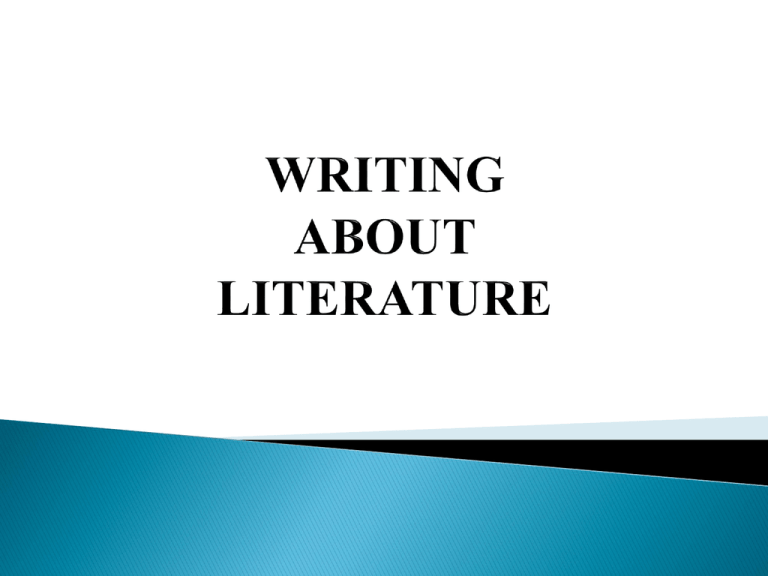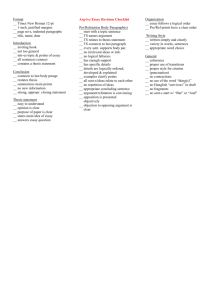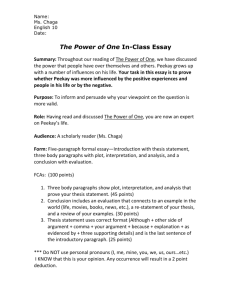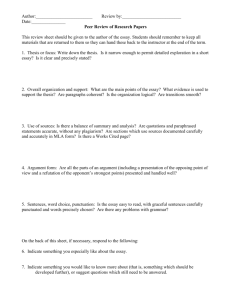Writing About Literature PPT
advertisement

READERS: ◦ teachers ◦ fellow students PRESUMPTIONS: ◦ Readers have read the story SO avoid plot summary* ◦ Readers are educated SO use a formal style and a sophisticated diction 3 WRITING PURPOSES: 1. to react to express a personal reaction to the work to express your feelings, emotional response personal response journal 2. to entertain to make the story more palatable rewriting of a sad or unresolved ending 4 WRITING PURPOSES: 3. to inform to summarize the plot plot summary 4. to persuade/to argue to persuade/argue to convince readers to agree w/your perspective persuasive letters to characters 5 “CRITICAL” : ◦ not “disapproving” or “fault-finding” ◦ but “thorough,” “thoughtful,” “inquisitive,” “logically demanding” 6 CRITICAL READING (explanation): ◦ discovering meanings & relationships ◦ often missed in quick, superficial reading ◦ (the same as “Critical Thinking”) 7 CRITICAL READING (process): 1. 2. 3. 4. 8 Analysis Inference Synthesis Evaluation CRITICAL READING (process): 1. ANALYSIS examining the parts/elements of the work to better understand it 9 plot, characterization, setting identifying the work’s central conflicts CRITICAL READING (process): 2. INFERENCE drawing conclusions regarding the work based on Analysis 10 the implications on meaning of plot, characterization, setting evaluating a main character (character sketch) CRITICAL READING (process): 3. SYNTHESIS creating a more informed understanding based on a combination of Analysis & Inference making connections, identifying patterns, drawing conclusions 11 the theme, central idea thesis statement CRITICAL READING (process): 4. EVALUATION defending the judgments made concerning the work’s meaning, significance, or quality 12 effectiveness, success, value, relevance arguing a work’s efficacy in portraying realities of war DEVELOPING IDEAS: 1. 2. 3. 4. 13 Self-Questioning Freewriting Problem-Solving Clustering DEVELOPING IDEAS: 1. SELF-QUESTIONING questions regarding characterization 14 motives, circumstances, fears, expectations, relationships conflict setting significance of repeated details value of events, actions DEVELOPING IDEAS: 2. FREEWRITING “free” 15 free of restrictions, grammatical conventions to “free” ideas from your subconscious “free association” start with a question from “Self-Questioning” answer it in essay format 10/15-minute time limit read over & note quality ideas DEVELOPING IDEAS: 3. PROBLEM-SOLVING explain a problematic part of the work for “Eveline,” the ending, why she stays 16 religion gender way she was brought up duty DEVELOPING IDEAS: 4. CLUSTERING focus on a crucial question related to “Problem-Solving” for “Eveline,” the ending, why she stays 17 religion gender way she was brought up duty THESIS: ◦ main idea, claim argument controlling idea ◦ concerning Theme 18 THEME: ◦ relate a Literary Element to the Theme ◦ something from your Analysis characterization plot setting ◦ don’t confuse “theme” with “moral” moral connotes value judgment, virtue/vice, good/evil sounds preachy, didactic, moralizing 19 THEMATIC THESIS: ◦ use a complete sentence: Topic = fragment the characterization of Eveline the role of the Church in “Eveline” dust as a symbol in “Eveline” Thesis = Topic + Main Idea Joyce’s characterization of Eveline as a dutiful daughter enables us to discover why she makes her strange decision at the end. The role of the Roman Catholic Church is crucial in shaping Eveline’s personality and in helping us understand her self-sacrifice. Joyce’s use of dust as a symbol reinforces our understanding of Eveline’s dreary, suffocating, arid life. 20 1. 2. 3. 22 Introduction Body Conclusion 1. ◦ ◦ ◦ ◦ ◦ INTRODUCTION introduce the subject & topic author’s full name work’s full title attention-getter state clearly the Thesis 23 1-sentence plot summary significant incident general statement about the story last sentence don’t announce (Ima Gonna) BODY 2. ◦ ◦ ◦ 24 provide Evidence to support the Thesis respond to opposing Claims (see below “Elements of Argument” & “Order”) CONCLUSION 3. ◦ ◦ ◦ sum up the Thesis reiterate main points justify the significance of the Thesis & Findings 25 the value of your discussion connection between your analysis & Theme, meaning ELEMENTS of ARGUMENT: 1. 2. 3. 4. 26 Claims Evidence Reasons Refutation ELEMENTS of ARGUMENT: 1. CLAIMS “Thesis” hypothesis, proposition, premise conclusions, recommendations based on an “Issue” a question raised concerning Theme see “Self-Questioning” & “Problem-Solving” Issue vs. Claim: o Secondary Claims = “Topic Sentences” 27 Issue = question, Claim = answer each paragraph = support of the Primary Claim starts with a “Topic Sentence” ELEMENTS of ARGUMENT: 2. EVIDENCE support, grounds, proof personal experience research o textual evidence o o o o o 28 secondary evidence **(the work itself) ** primary evidence facts, details, descriptions, incidents, key terms direct quotations from the work brief summaries of sections from the work ELEMENTS of ARGUMENT: 3. REASONING warrant, justify connecting your Evidence to your Claim explaining how you arrived at your interpretation Lead-In or Preview Sentences Warrant Statements or Clincher Sentences 1. 2. 3. 4. 5. 29 make a Claim (Topic Sentence) use Evidence (support) then interpret the meaning of the Evidence use more Evidence explain how Evidence supports Claim (Warrant Statement) ELEMENTS of ARGUMENT: 4. REFUTATION (or Rebuttal) Rogerian Method mention other interpretations anticipate objections to your claim prove how other Claims = faulty, limited, inaccurate placement 30 Introduction Body #1 as Lead-In to a particular point (segue, transition) as part of the Warrant Conclusion ORDER: ◦ EMPHATIC order – ** save the “most significant” point for LAST build emphasis appeals to logic, intelligence ◦ CHRONOLOGICAL order – time sequence follow the chronology of the work 31 PRIMARY SOURCE: ◦ if you are required to use only the text itself, ◦ merely include the page number (6). ◦ if you include a quote from another work from our textbook, ◦ then include the author’s last name, too (Joyce 6). (O’Connor 130). 33 SECONDARY RESEARCH: ◦ if you utilize researched material, ◦ you must consult & utilize proper MLA formatting (Author’s Last Name + page referent). 34 WORKS CONSULTED page: ◦ regardless of the type of sources employed, ◦ you will always include a Works Consulted page ◦ utilizing proper MLA formatting 35 INDUCTIVE REASONING: ◦ moving from the Specific to the General from Analysis to Evaluation from noticing specific parts of the work to drawing conclusions based on the work ◦ arrange your essay ◦ from Major Claim to Minor Claims Major Claim (Thesis) Minor Claims (Support) Conclusion 37 REFUTATION: ◦ arrange your essay ◦ by a Point-by-Point-by-Point refutation ◦ of the opposing (or commonly held) views 39 COMPARISON: ◦ similarities CONTRAST: ◦ differences arrange your essay ◦ through a C/C with another work ◦ through a C/C with another interpretation 41 PURPOSE: C/C 2 stories: ◦ helps us find out what something is by discovering what it is not ◦ we want to argue a point regarding Story B, so we C/C it to a similar story, Story A ◦ arrange essay by 1st discussing the similarities and 2nd by noting the differences, how Story B ends much differently from A by admitting the obvious similarities & then demonstrating the key differences, we gain a deeper understanding of Story B C/C 2 characters: ◦ we want to gain a deeper appreciation for a character in Story B, so we compare her to a seemingly different character from Story A ◦ arrange the essay by noting the differences and then proving the similarities by connecting the 2 in surprising & unsuspected ways, we understand better not only the one but both as well 42 SUBJECT-by-SUBJECT METHOD: ◦ work or character #1 point #1 (difference) point #2 (difference) point #3 (similarity) ◦ work or character #2 point #1 (difference) point #2 (difference) point #3 (similarity) 43 POINT-by-POINT-by-POINT METHOD: ◦ point #1 (similarity) work or character #1 work or character #2 ◦ point #2 (similarity) work or character #1 work or character #2 ◦ point #3 (difference) work or character #1 work or character #2 44





